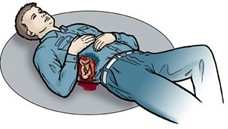The nurse provides care for a client recovering from a motor vehicle crash. For which sign of fluid volume overload does the nurse measure the client's intake and output? (Select all that apply)
Productive cough
Heart rate 112 beats/min
Blood pressure 96/52 mm Hg
Weight gain of 2 kg (4.4 lb)
Edema +2 of bilateral ankles and feet
Correct Answer : A,D,E
These are all signs of fluid volume overload. Measuring the client's intake and output can help the nurse monitor the client's fluid balance and detect any imbalances. A productive cough may indicate fluid accumulation in the lungs.
Weight gain and edema are also signs of fluid retention.

Nursing Test Bank
Naxlex Comprehensive Predictor Exams
Related Questions
Correct Answer is C
Explanation
This is because successful communication requires the efforts of all people involved in a conversation. Even when the person with hearing loss utilizes hearing aids and active listening strategies, it is crucial that others involved in the communication process consistently use good communication strategies. One of these strategies is to face the hearing-impaired person directly, on the same level and in good light whenever possible. Position yourself so that the light is shining on the speaker's face, not in the eyes of the listener ¹.
Correct Answer is ["A","C","D"]
Explanation
These are all important steps in rendering prescribed wound care for a child with an abdominal wound. Measuring the size of the wound helps to track healing progress. Working outward from the incision and wiping from a clean area to a less clean area helps to prevent infection.

Whether you are a student looking to ace your exams or a practicing nurse seeking to enhance your expertise , our nursing education contents will empower you with the confidence and competence to make a difference in the lives of patients and become a respected leader in the healthcare field.
Visit Naxlex, invest in your future and unlock endless possibilities with our unparalleled nursing education contents today
Report Wrong Answer on the Current Question
Do you disagree with the answer? If yes, what is your expected answer? Explain.
Kindly be descriptive with the issue you are facing.
